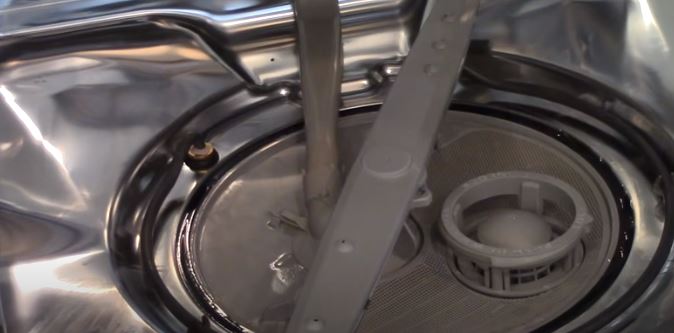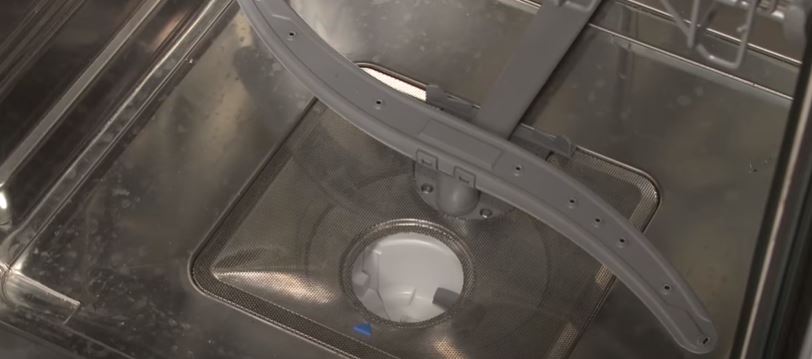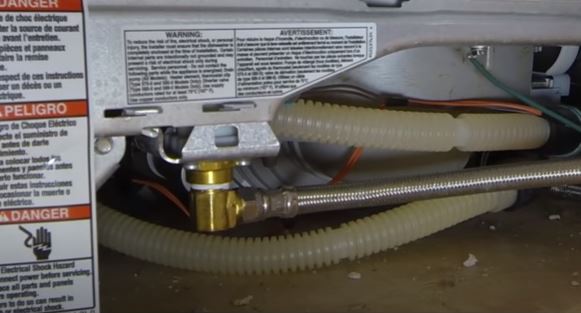
- A smelly dishwasher can result from trapped food debris, mold, mildew, or bacterial growth in hidden crevices, filters, or seals.
Cleaning Steps
- Empty the Dishwasher: Remove all dishes, racks, and utensil holders to access the entire dishwasher.
- Inspect for Food Debris: Check the dishwasher’s drain, spray arms, and filter for food particles or debris, which can contribute to the smell.
- Wipe Down Interior: Mix a solution of equal parts water and white vinegar or use baking soda. Wipe down the interior, including the walls, door gasket, and any visible mold or mildew spots.
- Clean Removable Parts: Remove and clean removable parts, such as racks, filters, and utensil holders, separately using the vinegar solution or baking soda paste.
- Use Vinegar: Place a dishwasher-safe cup filled with white vinegar on the top rack. Run a hot water cycle (empty) to disinfect and deodorize the dishwasher.
- Baking Soda: Alternatively, sprinkle baking soda on the dishwasher floor and let it sit for a few hours or overnight. Then, run a short, hot water cycle to remove any remaining odors.
- Clean Seals and Gaskets: Pay attention to the door gasket and seals. Clean them carefully with the vinegar solution to ensure no mold or residue remains.
- Regular Maintenance: Develop a routine for cleaning your dishwasher, checking for food debris, and wiping down the interior to prevent future odors.
- Ventilation: Ensure proper ventilation in the kitchen, as good airflow can help reduce moisture levels and prevent mold and mildew growth.
- Rinse Aid: Consider using a rinse aid in your dishwasher to help dishes dry faster and reduce moisture levels, which can deter mold growth.
How to Clean a Smelly Dishwasher
The following are the steps to follow when cleaning a smelly dishwasher;
1. Remove the Lower Dish Rack
Due to how gravity works, any water that is unable to drain out of the dishwasher will be pooling at the bottom. The spray arm and drain filter are also found at the bottom of the dishwasher.
It is therefore easy to remove the drain filter and spray arm with the lower dish rack out of the way. That also gives you a chance to clean the dish rack in the sink.
2. Clean the Drain Filter

In most of the cases where you have a smell dishwasher, a clogged drain filter is usually the culprit. The filter could be partially or fully clogged by a combination of food particles and grease.
A dishwasher filter like all the other filters has tiny openings which sieve out the wastewater preventing food scraps and other debris from clogging up the drain pump.
The problem is that if you don’t rinse your dishes properly before loading then in the dishwasher, all the food scraps and grease will end up clogging the filter and once they start decomposing the smell from the dishwasher will be awful.
If your dishwasher is also not draining, a clogged drain pump filter could also be the problem. By cleaning it you will be solving that problem as well.
The good thing is that cleaning a dishwasher is very simple. For most dishwasher models, you will only need to twist the filter ¼ turn counterclockwise or clockwise in some and then lift it off. For some models you will only need to lift it off.
if your filter is screwed in, you will need to remove the screws using a screwdriver then lift it off.
Drop the filter in a bowl or pan and soak it with warm soapy water. As you wait for the gunk to loosen up, use a cloth dipped in soapy water to clean the dishwasher sump (the hole where the filter was installed).
Use an old toothbrush to clean the drain filter until all the holes are fully opened. Rinse it with running water in the sink.
3. Clean the Spray Arm

Water from the dishwasher tub is pumped into the spray arm where it comes out through small holes under pressure to clean the dishes. The spray arm holes can therefore get clogged by food scraps and grease resulting in a smelly dishwasher.
To remove the dishwasher spray arm, grab it and give it a ¼ turn counterclockwise and lift it off. Some dishwasher models have more than one spray arm so be sure to remove the others if you have them.
Again, use warm soapy water to clean the spray arm. To unclog the holes, poke through each one of them using a wire. Sometimes you may have to soak the spray arm in vinegar to completely break the gunk inside.
4. Drain Standing Water
Is there standing water at the bottom of your dishwasher? If you have just returned from a trip or haven’t used your dishwasher for some time, standing water can start to go stale as well as encourage the growth of mold.
While you can drain standing water by simply soaking it with a sponge and cleaning the mold with vinegar and baking soda, you should investigate further as to why the dishwasher is not draining in the first place.
As I had mentioned earlier, a clogged drain filter is one of the causes. The problem could also be caused by a kinked, poorly installed or clogged drain hose.
5. Wipe the Interior of the Dishwasher
Although most food scraps will be trapped in the drain filter, and spray arm, it could also find crevices to hide inside the other parts of the dishwasher.
Use a cloth and warm soapy water to wipe every corner of the dishwasher without forgetting the top rack and all the corners, nooks and crevices.
One place you may forget to clean but where food scraps and grease accumulate a lot is the dishwasher door gasket/seal. The dishwasher door gasket flap can hide a lot of food particles and grease and after some time start to smell badly. That is also the same thing that happens with washing machines when start to smell.
Run the wet cloth severally through the door gasket flaps until it is spotlessly clean.
6. Clean the Dishwasher Drain Hose

A dishwasher drain hose is connected from the drain pump to the garbage disposal. If you have an air gap, it will be connected to the first branch of the dishwasher while another hose will be connected from the other branch to the garbage disposal or sink drain line.
For people who do not have a dishwasher air gap, the drain hose is looped high underneath the sink counter and connected directly to the garbage disposal or kitchen sink drain line.
Check if the drain hose is properly looped high enough or if it is kinked. It is not possible to see a clog but if any of that is the problem, wastewater will not drain out of the dishwasher completely and will end up resulting in bad smell.
If your drain hose is installed in such a way that it allows water to accumulate inside it, odors will continue to waft out of the dishwasher or even garbage disposal.
I like to disconnect the dishwasher drain hose and inspecting it physically.
- Start by removing the lower dishwasher access panel also known as a kick toe. It is held using 2 or 4 screws
- On the right bottom corner, you will see where the drain hose is connected to the drain pipe.
- Place a towel underneath the connection to soak up any water still trapped in the hose.
- Pinch the clump using a pair of pliers and pull the hose out of the pump. As the water drains out, notice if there is a strong stench coming out as well. If there is, the drain hose is the culprit.
- Disconnect the drain hose from the garbage disposal as well.
- Blow air through the drain hose to force out any debris/clogs that may be inside it.
- Seal one end of the drain hose using a plastic bag and rubber then proceed to fill the hose with vinegar. When it’s full seal the other end as well.
- Let the vinegar sit for about 30 minutes or longer.
- Pour out the vinegar then blast hot water through the drain hose to flush out any lingering debris.
- When the hose is clean and without and smells, connect it back. Before that, clean the dishwasher inlet on the garbage disposal.
7. Clean the Dishwasher Air Gap
A dishwasher air gap prevents wastewater from being siphoned back to the dishwasher when the kitchen sink drain line or garbage disposal are clogged. Instead, water flows from the air into the sink.
With time, food scraps and grease can clog the air gap and result in a bad smell as well. The good thing about clean an air gap is that it is very easy.
Start by removing the top cover and the cap then insert a bottle brush in a household detergent and shove it up and down until the air gap is cleaned and the smell is gone.
Alternatively, you can disconnect the air gap drain hose from the garbage disposal and clean it from that end.
8. Clean the Dishwasher Using Vinegar and Baking Soda

After cleaning all the components of a dishwasher independently, you should next clean the entire unit using baking soda and vinegar.
This is usually a very easy thing to do and I would recommend that you do it at least 4 times a year to prevent the dishwasher from smelling in the first place. It will also prevent clogs and as a result standing water at the bottom of the dishwasher.
- Fill a bowl with white vinegar and place it on the top dish rack.
- Spray about a cup of baking soda at the bottom of the dishwasher then close the door.
- Run the dishwasher through one cycle on the highest possible setting.
And that is all you need to do.
Citric Acid for Smelly Dishwasher
If you don’t have white vinegar or just don’t like its smell, citric acid is a fantastic alternative. It smells like lemon and we all like the smell of lemon.
Spray about ¼ cup of citric acid powder at the bottom of the dishwasher then run a cycle with and empty dishwasher. Alternatively you can use a cup of fresh strained lemon juice.
9. Let It Dry
After cleaning the dishwasher, leave the door open for about an hour to let in fresh and cool air. This will help it dry, preventing smells.
As I had mentioned earlier, not all the water will drain out of the dishwasher. By leaving the door open, you are allowing the water to evaporate, especially the one trapped in the filter and door gasket, giving bad smells no chance.
Make it a habit of leaving your dishwasher door open after cleaning it or even after you are done doing the dishes.
Prevention
The following are some of the ways to prevent a smelly dishwasher:
- Scrape dishes and wipe off/rinse grease before loading them in the dishwasher
- Clean the drain filter as often as possible.
- Clean the dishwasher using baking soda and vinegar or citric acid frequently.
- Install a dishwasher air gap if you do not already have one.
And basically that is how to clean a smelly dishwasher.





